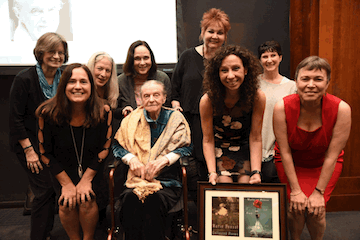Submission Guidelines for Essays
ezzo Cammin welcomes submissions of essays on any aspect of poetry in form by women. Suggested topics include studies of the work of a single author or group of authors; studies of how women have treated a particular form (such as the sonnet, or experimental forms); or controversies surrounding women writers and form (such as canonization or evolving attitudes toward poetic form).
 |
 Although we do not require essays to focus primarily or exclusively on formal elements of the poetry discussed, we do expect that essay writers will include some commentary on form as a way of illuminating their arguments. Although we do not require essays to focus primarily or exclusively on formal elements of the poetry discussed, we do expect that essay writers will include some commentary on form as a way of illuminating their arguments.
|
|
 |
Although we do not require essays to focus primarily or exclusively on formal elements of the poetry discussed, we do expect that essay writers will include some commentary on form as a way of illuminating their arguments. We do not limit our purview to the twentieth century, or to poetry in English; however, we do ask you to provide translations if you submit an essay on women poets who write in languages other than English. Also, for essays accepted for publication in Mezzo Cammin, we may ask the writer to assist us in obtaining permission to quote coyrighted material. Unfortunately, at this time we do not pay for essays. We plan to run special features on a particular author or topic at least every other issue; the new topic will be announced in the preceding issue. Our preferred length is 5000 words (20 pages) but shorter or longer pieces may be considered. Please follow MLA citation format.
Please submit original, unpublished essays or queries as e-mail attachments in RTF (rich text format), to: kbridgford@yahoo.com
Poetry Submission Guidelines
Mezzo Cammin welcomes submissions of poetry that pays particular consideration to form. Poems in structured forms are especially welcome, but poems that use form in interesting and experimental ways are also encouraged.
Please submit four-six unpublished poems as e-mail attachments in RTF (rich text format) to kbridgford@yahoo.com.
|
|
 |
 |
|
|
 |
 |
The most recent addition to The Mezzo Cammin Women Poets Timeline is Rosa Newmarch by Jean L. Kreiling.
Marie Ponsot was presented with a Lifetime Achievement Award at the Celebration of the Timeline reaching 75 essays, Lincoln Center, Fordham University (Sponsored by Fordham's Curran Center) Friday, October 20th, 2017.
Charlotte Innes is the recipient of the 2018 Mezzo Cammin Scholarship to the Poetry by the Sea conference.
|
|
|
 |
|
|
|
 |
| Rachael Gorchov: Recently I completed a body of work that focused on the landscapes that define suburban office and industrial complexes, contemplating their subtle relationships with the history of landscape painting. When looking at these places I saw English landscape gardens – orchestrated nature that gave way to picturesque landscape painting. I documented my subjects onsite by drawing their reflections in a Claude Glass, a convex black mirror popularized as an observation device in the 18th century. This tool appealed to me for how its skews and bulges its reflection, making my work highly subjective from the start. I then constructed paintings in the studio based on these drawings. The three-dimensional nature of my paintings further emphasized the forced perspective in my initial drawings and required viewers to explore the paintings much like they might explore a physical space by moving around, crouching and craning their necks.
Irregular versions of geometric forms such as cubes, parabolic curves, cones and triangles comprised the dimensional shapes of these pieces and eventually gave way to my working nearly exclusively on concave surfaces and ‘rocks with cast shadows.’ I settled on these structures for a few reasons. When a viewer stands directly in front of the concave works, irregular half-spheres with the convex side attached to the wall, the paintings fill their peripheral vision for an immersive experience. The rocks and shadows, amorphous objects paired with adhesive-backed prints, are reminiscent of portals and geologic abrasions. They invite viewers to question if the dimensional form is emerging from or entering into another space. Like in other works, these pieces frame the physical space the artworks inhabit.
In 2016, I visited Europe where I recognized parallels between the interiors of Renaissance spaces and my own paintings, such as the power that foreshortening possesses in its ability to collapse and intensify space in cathedrals– similar to my Claude Glass works. This experience coincided with a visit to an exhibition in Vienna featuring renderings of synagogues that once stood in the city. This piqued an interest in contemplating architectural space in my work and prompted me to consider architectural language in my own Jewish cultural heritage. I then began a series of tondos, a Renaissance term for circular artworks, of European Jewish architecture.
Beginning with paintings and mixed-media, in these works I build a photographic image that engages the space wherever it is installed, becoming part of the architecture. I arrived at the tondo format through my own history of making non-rectangular paintings, and appreciate its relationship to reliefs and rose windows found in synagogues and cathedrals. In gathering source imagery, I rely heavily on documentation – photographs and engravings as most of these buildings have been destroyed. I contemplate the collective memory images of architectural space can reveal. In this spirit, this work depicts layered environments where scale, color and depth shift ambiguously, revealing experiential space.
I consistently begin works by looking at a particular subject because of an art historical or personal association, and then through a process of extracting details from their surroundings using an accumulation of marks, color and a tactility, I sacrifice specificity of form and place, ultimately revealing a specificity of experience as my subject.
|
|
|
|
|
|
 |
|
 |
|
|
|
|
